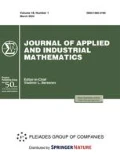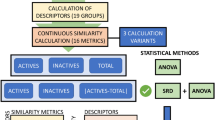Abstract
Measures of similarity between objects in a metric space and a competitive space are described. The function of rival similarity is proposed as a similarity measure used in the problems of classification and pattern recognition. This function enables us to develop effective algorithms for solving all major problems of data mining, to obtain a quantitative estimate of pattern compactness and informativity of the feature space, and to construct simply interpreted decision rules. The method is applicable to the problems with arbitrary number of patterns and any character of their distributions, and it can be also used for solving ill-conditioned problems.
Similar content being viewed by others
References
Yu. A. Voronin, Basics of Similarity Theory (Vychisl. Tsentr, Novosibirsk, 1989) [in Russian].
Yu. A. Shreider, Equality, Similarity, and Order (Nauka, Moscow, 1971) [in Russian].
E. Fix and J. Hodges. “Discriminatory Analysis. Nonparametric Discrimination. Consistency Properties,” Techn. Rep. 21-49-004 (USAF School of Aviation Med., Randolph Field, TX, 1951).
K. Kira and L. Rendell, “The Feature Selection Problem: Traditional Methods and a New Algorithm,” in Proceedings of the 10th Conference “Artificial Intelligence (AAAI-92) (AAAI Press, Menlo Park, 1992), pp. 129–134.
N. G. Zagoruiko, Applied Methods for the Data and Knowledge Analysis (Vychisl. Tsentr, Novosibirsk, 1989) [in Russian].
E. M. Braverman, “Experiences on Training the Machine to Recognition of Visual Patterns,” Automatics and Telemechanics 23(3), 349–365 (1962).
K. V. Vorontsov and A. O. Koloskov, “Compactness Profiles and Selection of the Reference Objects in Metric Algorithms of Classification,” Iskusstv. Intellekt, No. 2, 30–33 (2006).
N. G. Zagoruiko, I. A. Borisova, V. V. Dyubanov, and O. A. Kutnenko, “Methods of Recognition Based on the Function of Rival Similarity,” Pattern Recognition and Image Analysis 18(1), 1–6 (2008).
I. Guyon, J. Weston, S. Barnhill, and V. Vapnik, “Gene Selection for Cancer Classification Using Support Vector Machines,” Machine Learning 46(1–3), 389–422 (2002).
T. R. Golub, D. K. Slonim, P. Tamayo, C. Huard, M. Gaasenbeek, J. P. Mesirov, H. Coller, M. L. Loh, J. R. Downing, M. A. Caligiuri, C. D. Bloomfield, and E. S. Lander, “Molecular Classification of Cancer: Class Discovery and Class Prediction by Gene Expression Monitoring,” Science 286 (1999) [see http://www.genome.wi.mit.edu/MPR/data-set-ALL-AML.html].
T. Merill and O. M. Green, “On the Effectiveness of Receptions in Recognition Systems,” IEEE Trans. Inform. Theory. IT-9, 11–17 (1963).
I. A. Borisova, V. V. Dyubanov, N. G. Zagoruiko, and O. A. Kutnenko, “Similarity and Compactness,” in Proceedings of the 14th All-Russian Conference on Mathematical Methods of Image Recognition (Moscow, 2009), pp. 89–92.
N. G. Zagoruiko, O. A. Kutnenko, and A. A. Ptitsin, “Algorithm GRAD for Selection of Informative Genetic Feature,” in Proceedings of the International Conference on ComputationalMolecular Biology (Moscow, 2005), pp. 8–9.
N. G. Zagoruiko and O. A. Kutnenko, “Recognition Methods Based on the AdDel Algorithm,” Pattern Recognition and Image Analysis 14(2), 198–204 (2004).
V. V. Dyubanov, “Application of the FRiS-Function for Solving the Problem of Demand Forecasting (Algorithm FRiS-Pro),” in Proceedings of All-Russian Conference “Knowledge-Ontology-Theory” (ZONT-09), Vol. 2 (Novosibirsk, 2009), pp. 258–260.
A. B. Bogdanov, I. A. Borisova, V. V. Dyubanov, N. G. Zagoruiko, O. A. Kutnenko, A. V. Kuchkin, M. A. Meshcheryakov, and N. G. Milovzorov, “Intellectual Analysis of Spectral Data,” Avtometriya, No. 1, 92–101 (2009).
Author information
Authors and Affiliations
Corresponding author
Additional information
Original Russian Text © N.G. Zagoruiko, I.A. Borisova, V.V. Dyubanov, O.A. Kutnenko, 2010, published in Sibirskii Zhurnal Industrial’noi Matematiki, 2010, Vol. XIII, No. 1, pp. 59–71.
Rights and permissions
About this article
Cite this article
Zagoruiko, N.G., Borisova, I.A., Dyubanov, V.V. et al. A quantitative measure of compactness and similarity in a competitive space. J. Appl. Ind. Math. 5, 144–154 (2011). https://doi.org/10.1134/S1990478911010157
Received:
Published:
Issue Date:
DOI: https://doi.org/10.1134/S1990478911010157




